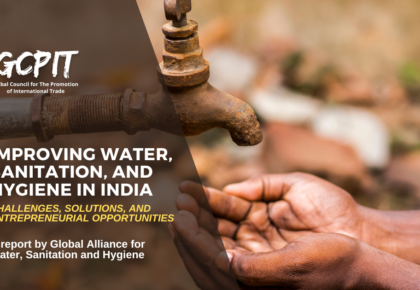
South Africa is a country located in the southernmost region of Africa. It has a population of around 60 million people and is known for its diverse culture and economy. Despite the country’s vast natural resources, its water and sanitation systems have been facing major challenges. The main challenge is the lack of access to safe drinking water and sanitation facilities, particularly in rural areas. According to the United Nations, approximately 4.2 million people in South Africa lack access to safe drinking water, and 21 million do not have access to basic sanitation facilities. These issues have significant implications for public health and economic development.
Challenges: One of the major challenges faced by South Africa is the lack of infrastructure to provide safe drinking water and sanitation facilities. In many rural areas, people still rely on rivers and streams for their water supply, which is often contaminated and leads to the spread of waterborne diseases. Furthermore, the lack of proper sanitation facilities, particularly in schools and health facilities, poses significant health risks to the population. The poor water quality and sanitation conditions contribute to the high incidence of waterborne diseases, such as cholera and typhoid fever.
Another challenge is the management of water resources in the country. South Africa has a semi-arid climate, and the availability of water varies greatly depending on the region. Water scarcity is a major problem in many areas, particularly during periods of drought. In addition, the country faces challenges related to water pollution, which affects both the quality and quantity of water resources. Industrial pollution, as well as inadequate wastewater treatment, contribute to the pollution of water resources.
The following are some of the major challenges:
-
Water scarcity: South Africa is a water-scarce country, with limited water resources available to meet the needs of its growing population. This leads to frequent water shortages and uneven distribution of water resources, which affect the availability and accessibility of water for households and communities.
- Poor sanitation facilities: Many people in South Africa lack access to basic sanitation facilities, such as toilets and hand-washing facilities. This leads to poor hygiene practices and increases the risk of diseases such as cholera and diarrhoea.
- Inadequate water treatment: The quality of water in South Africa is often compromised due to inadequate treatment of wastewater and drinking water. This can lead to the spread of water-borne diseases and other health risks.
- Unequal access to WASH services: Access to WASH services is often unevenly distributed across different regions and social groups. This can lead to disparities in health outcomes and economic opportunities.
- Limited investment in WASH infrastructure: South Africa’s WASH infrastructure is often outdated and poorly maintained, with limited investment in new infrastructure. This affects the quality and availability of water and sanitation services.
- Limited access to finance: Many households and communities in South Africa struggle to access finance to improve their WASH infrastructure or to start businesses related to WASH.
- Climate change: Climate change has led to increased water scarcity and more frequent extreme weather events, such as floods and droughts, which affect the availability and quality of water resources.
- Limited awareness of hygiene practices: Many people in South Africa have limited awareness of proper hygiene practices, which can lead to the spread of diseases.
- Poor governance: Corruption and mismanagement of WASH resources have been identified as key challenges in South Africa, leading to poor service delivery and limited investment in infrastructure.
-
High poverty levels: Poverty is a key driver of WASH challenges in South Africa, as many people lack the resources to invest in their own infrastructure or to access WASH services.
Solutions Implemented by the Country: To address these challenges, South Africa has implemented several initiatives to improve access to safe drinking water and sanitation facilities. The government has made significant investments in water and sanitation infrastructure, particularly in rural areas. For example, the government launched the Accelerated Community Infrastructure Programme (ACIP) in 2006, which aims to provide basic water and sanitation services to households in rural areas. The program has provided more than 400,000 households with access to basic sanitation facilities and 600,000 households with access to safe drinking water.
The government has also implemented policies to improve the management of water resources in the country. The National Water Act of 1998 established a framework for the management of water resources, which includes measures to ensure sustainable use of water resources and the protection of water quality. The government has also invested in the development of wastewater treatment facilities, which has helped to reduce water pollution in many areas.
South Africa faces significant challenges in ensuring access to safe water, sanitation, and hygiene. These challenges are compounded by factors such as poverty, inequality, and high unemployment rates. In response to these challenges, the South African government has implemented a range of solutions to improve access to water, sanitation, and hygiene. Here are 10 top and unique solutions implemented by the country:
- The establishment of the National Water Act: The National Water Act of 1998 regulates the use of water in South Africa and provides a framework for the sustainable management of water resources. The Act has helped to promote better management of water resources and to ensure that water is used more efficiently.
- Implementation of the Bucket Eradication Programme: In many informal settlements in South Africa, residents have to rely on bucket toilets, which can lead to poor sanitation and hygiene. The Bucket Eradication Programme aims to replace these toilets with more modern and hygienic options.
- Provision of free basic water: The South African government provides free basic water to households that earn less than a certain amount per month. This initiative has helped to improve access to safe water for millions of people.
- The establishment of the Department of Water and Sanitation: In 2014, the South African government established the Department of Water and Sanitation to oversee the management of water resources and the provision of water and sanitation services. The department has played a key role in promoting better water management and improving access to safe water and sanitation.
- The implementation of the Blue Drop certification system: The Blue Drop certification system is a quality assurance program for drinking water quality management. It provides a framework for municipalities to manage their water supply systems and to ensure that water is safe for human consumption.
- Investment in water infrastructure: The South African government has invested heavily in water infrastructure, including the construction of dams, water treatment plants, and pipelines. This investment has helped to improve access to safe water for millions of people.
- The establishment of the National Sanitation Programme: The National Sanitation Programme aims to provide access to basic sanitation for all South Africans by 2030. The programme includes the provision of sanitation facilities in schools and clinics, and the construction of new sanitation facilities in areas where they are needed.
- Promotion of water conservation: The South African government has launched several campaigns to promote water conservation and to encourage households and businesses to use water more efficiently. These campaigns have helped to reduce water consumption and to improve water security.
- The implementation of the War on Leaks programme: The War on Leaks programme aims to reduce water losses from leaking pipes and to promote better management of water resources. The programme provides training to young people to become plumbers and leak detectors.
- The use of mobile technology to monitor water quality: The South African government has developed a mobile application called “My Water Quality” that allows citizens to report water quality issues in their communities. The app uses GPS to locate the source of the problem, and this information is used to improve water management and to ensure that water is safe for human consumption.
These solutions have helped to improve access to safe water, sanitation, and hygiene in South Africa. However, there is still much work to be done to ensure that all South Africans have access to these basic services.
Opportunities for entrepreneurs: Entrepreneurship can play a critical role in addressing the water, sanitation, and hygiene challenges faced by South Africa. In recent years, the country has witnessed a growing interest in entrepreneurship, with the government taking steps to support small businesses and startups. Entrepreneurship in the WASH sector can help create new jobs, introduce innovative solutions, and improve access to safe water and sanitation services. This section will discuss ten opportunities for entrepreneurs in South Africa to solve the WASH issues.
- Mobile applications: The use of mobile applications for water quality monitoring and reporting can improve access to information about the quality of water sources and help identify contaminated sources. Entrepreneurs can develop and launch mobile applications that enable users to collect and report water quality data in real-time.
- Decentralized Wastewater Treatment: Decentralized wastewater treatment systems (DEWATS) can provide cost-effective and sustainable solutions for wastewater management in rural and peri-urban areas. Entrepreneurs can establish small-scale DEWATS businesses that design, construct, and maintain DEWATS systems.
- Rainwater harvesting: Rainwater harvesting can help address water scarcity challenges in South Africa. Entrepreneurs can offer innovative rainwater harvesting solutions for households, businesses, and communities.
- Water purification technologies: South Africa faces water quality challenges due to pollution and contamination. Entrepreneurs can develop and market innovative water purification technologies that can provide affordable and sustainable solutions.
- Sanitation technology: Entrepreneurs can design and develop innovative sanitation technologies that address the challenges faced by informal settlements and rural areas. Sanitation solutions can include low-cost toilets, fecal sludge management, and wastewater treatment technologies.
- Water conservation solutions: Entrepreneurs can develop and offer water conservation solutions to households, businesses, and industries. These solutions can include water-efficient technologies, leak detection and repair, and behavior change campaigns.
- Public-private partnerships: Entrepreneurs can explore opportunities to partner with the government and other stakeholders to provide WASH services. Public-private partnerships can help leverage resources, expertise, and networks to address WASH challenges in a more sustainable and scalable manner.
- Community-led initiatives: Entrepreneurs can work with communities to develop and implement community-led initiatives for WASH services. These initiatives can include community water and sanitation management committees, water source protection, and hygiene promotion campaigns.
- Financing mechanisms: Entrepreneurs can develop and offer innovative financing mechanisms for WASH services. These can include microfinance, crowd-funding, and impact investment models that can provide access to finance for WASH entrepreneurs and households.
- Research and development: Entrepreneurs can conduct research and development to develop and test new WASH solutions. This can include product development, technology adaptation, and testing, and monitoring and evaluation of WASH programs.
Overall, there are numerous opportunities for entrepreneurs in South Africa to address WASH challenges. These opportunities can help create new jobs, introduce innovative solutions, and improve access to safe water and sanitation services. However, entrepreneurship in the WASH sector also faces challenges, including access to finance, markets, and networks, and regulatory barriers. Policymakers and stakeholders can take steps to support WASH entrepreneurship by providing access to finance and markets, developing supportive policies and regulations, and building networks and partnerships.
Outcome of the solutions: The South African government’s commitment to improving access to safe water and sanitation has yielded significant results. By implementing policies and programs to address the challenges of inadequate water supply, poor sanitation, and inadequate hygiene practices, the country has made progress towards achieving its goal of universal access to water and sanitation by 2030. The government has worked to increase investment in water infrastructure, improve management of water resources, and engage with communities to promote behavioral change.
As a result of these efforts, millions of South Africans now have access to safe water and improved sanitation facilities, and the country has seen a reduction in waterborne diseases. In addition, the government’s focus on promoting hygiene practices has improved public health outcomes and reduced the burden of preventable illnesses. These achievements have contributed to improving the quality of life for many South Africans and have had a positive impact on the country’s economic development.
South Africa has made significant progress in addressing water, sanitation, and hygiene challenges in the country. Despite these achievements, significant challenges remain, including inadequate water supply, poor sanitation, and inadequate hygiene practices. The government has implemented several solutions to address these challenges, and entrepreneurs have an important role to play in further improving the situation.
- Increased Access to Clean Water: One of the most significant outcomes of the solutions implemented in South Africa is the increased access to clean water. The country has made significant progress in providing safe and sustainable water sources to its citizens. In 1994, only 62% of the population had access to safe water. By 2017, this number had increased to 92%.
- Improved Sanitation: Another important outcome of the solutions implemented in South Africa is the improvement in sanitation. The country has made significant progress in providing basic sanitation to its citizens. In 1994, only 50% of the population had access to basic sanitation. By 2017, this number had increased to 81%.
- Reduced Water Losses: South Africa has implemented measures to reduce water losses through leak detection and repair, metering, and pressure management. This has resulted in significant savings in water and improved water supply.
- Improved Wastewater Treatment: South Africa has invested in the development of wastewater treatment plants, resulting in improved water quality and reduced pollution of rivers and other water sources.
- Water Conservation: South Africa has implemented water conservation measures such as water restrictions and public awareness campaigns to reduce water consumption and increase water efficiency.
- Private Sector Participation: South Africa has encouraged private sector participation in the provision of water and sanitation services, leading to increased investment and innovation in the sector.
- Community-Based Water Management: The country has implemented community-based water management programs, empowering communities to manage and maintain their water sources.
- Education and Awareness: South Africa has implemented education and awareness programs to promote water conservation and hygiene practices, leading to improved health outcomes.
- Technology Adoption: South Africa has adopted innovative technologies such as mobile water treatment plants, solar-powered water pumps, and water-saving devices to improve water supply and efficiency.
-
Sustainable Financing: South Africa has implemented sustainable financing models such as cost recovery and public-private partnerships to ensure the long-term sustainability of water and sanitation services.
The implementation of successful water, sanitation, and hygiene (WASH) programs often requires the cooperation and partnership of both public and private sectors. Private-public partnerships, alliances, and collaborations can provide unique benefits to WASH programs, such as increased funding, access to technology and expertise, and improved efficiency in implementation. South Africa has seen the positive effects of such partnerships in its WASH sector.
Implication of Private-public partnerships, alliances, and collaborations on country’s water, sanitation, and hygiene (WASH) sector: One of the most successful examples of private-public partnership in South Africa’s WASH sector is the WASH United program. The program is a partnership between the South African government and several private companies, including Unilever, Procter & Gamble, and Nestle. The program aims to provide WASH education and hygiene promotion to school children in disadvantaged areas of the country. Through the program, the private companies provide funding, expertise, and hygiene products, while the government provides the infrastructure and implementation support.
Another example is the Water Research Commission’s (WRC) partnerships with private companies to develop and implement water-saving technologies. The WRC partners with companies such as Coca-Cola and Sasol to research and develop innovative technologies that reduce water usage in their operations. Through these partnerships, the private companies benefit from reduced costs and improved sustainability, while the WRC gains access to the companies’ expertise and technology.
Collaborations between NGOs and private companies have also been successful in addressing WASH issues in South Africa. For example, the NGO WaterAid has partnered with the South African Breweries (SAB) to provide WASH education and infrastructure in communities surrounding SAB’s breweries. Through the partnership, SAB provides funding and implementation support, while WaterAid provides the technical expertise and community engagement.
These private-public partnerships, alliances, and collaborations have led to significant improvements in South Africa’s WASH sector. According to the South African government’s 2019 National Sanitation Progress Report, the percentage of households with access to basic sanitation increased from 62.3% in 2002 to 81.2% in 2019. Additionally, the percentage of households with access to basic water supply increased from 85.4% in 2002 to 92.1% in 2019. These improvements can be attributed in part to the successful partnerships between the public and private sectors in the country’s WASH sector.
Private-public partnerships, alliances, and collaborations have been instrumental in addressing the WASH challenges in South Africa. These partnerships have resulted in improved access to basic sanitation and water supply, as well as the development of innovative technologies and the provision of WASH education to communities. As such, it is essential that these partnerships continue to be fostered and strengthened to further improve the country’s WASH sector.
Conclusion: Access to safe and adequate water, sanitation, and hygiene is critical for public health and sustainable development. The case study of South Africa highlighted the significant challenges the country faces in ensuring adequate WASH services for all its citizens, including inadequate infrastructure, limited resources, and a history of inequality. However, the country has made significant progress in addressing these challenges through various innovative and effective solutions, including policies and regulations, infrastructure development, and community empowerment.
Through the implementation of policies such as the National Sanitation Policy and the Water Services Act, South Africa has established a framework for improving WASH services. Investment in infrastructure, including the installation of communal taps and toilets in informal settlements, has significantly increased access to WASH services for underserved communities. Community-led initiatives, such as the Community Water Supply and Sanitation Programme, have empowered communities to take ownership of their WASH services and ensure their sustainability.
Entrepreneurs have played a critical role in addressing the challenges faced by South Africa in the WASH sector. Opportunities for entrepreneurship include the development of innovative technologies such as water treatment systems and sanitation solutions, as well as the creation of small-scale water supply and sanitation services in rural and underserved areas. These opportunities can be further explored through partnerships and collaborations with the government and civil society.
The outcomes of these solutions have been significant, with increased access to safe water and improved sanitation leading to a reduction in waterborne diseases such as cholera and diarrhea. Additionally, the provision of WASH services has contributed to economic development, with increased productivity and reduced healthcare costs. The success of these solutions demonstrates the importance of partnerships and collaborations in the WASH sector and the potential for entrepreneurship to drive innovation and sustainability.
In light of the continued challenges faced by South Africa in ensuring adequate WASH services for all, it is essential to continue to prioritize and invest in the sector. The involvement of the private sector, civil society, and communities in partnerships and collaborations with the government will be critical to ensuring sustainability and equitable access to WASH services. By addressing the challenges and leveraging opportunities, South Africa can continue to make progress towards achieving the Sustainable Development Goals and ensuring the right to water and sanitation for all its citizens.
Overall, the case study of South Africa demonstrates the importance of political will, innovative solutions, and partnerships in addressing the challenges and achieving the goals of the WASH sector. The country’s progress in providing access to safe water, improved sanitation, and hygiene services offers valuable lessons for other countries facing similar challenges. By learning from the experiences of South Africa and continuing to invest in WASH services, we can create a future where all people have access to these essential services and the benefits that come with them.
References:
-
Department of Water and Sanitation (2018). Water and Sanitation Master Plan. Available at: https://www.dwa.gov.za/Documents/Other/Water%20and%20Sanitation%20Master%20Plan.pdf.
- Republic of South Africa. (2018). National Sanitation Strategy: Consolidated Version. Available at: http://www.gov.za/sites/www.gov.za/files/national_sanitation_strategy.pdf
- Water Research Commission (2018). South African Sanitation Technology Demonstration Programme. Available at: http://www.wrc.org.za/Knowledge%20Hub%20Documents/Research%20Reports/KV%20South%20African%20Sanitation%20Technology%20Demonstration%20Programme.pdf.
- Department of Water and Sanitation. (2019). Blue Drop Certification. Available at: https://www.dwa.gov.za/BDP/.
- World Bank. (2019). South Africa: Water and Sanitation Program. Available at: https://www.worldbank.org/en/results/2019/02/27/south-africa-water-and-sanitation-program.
- Department of Environmental Affairs. (2019). National Environmental Management: Waste Act, 2008 (Act No. 59 of 2008). Available at: https://www.environment.gov.za/sites/default/files/legislations/nema_wasteact59_2008.pdf.
- Department of Water and Sanitation. (2018). Water and Sanitation Master Plan. Available at: https://www.dwa.gov.za/Documents/Other/Water%20and%20Sanitation%20Master%20Plan.pdf.
- Water Research Commission. (2018). South African Sanitation Technology Demonstration Programme. Available at: http://www.wrc.org.za/Knowledge%20Hub%20Documents/Research%20Reports/KV%20South%20African%20Sanitation%20Technology%20Demonstration%20Programme.pdf.
- United Nations Development Programme. (2018). South Africa Human Development Report 2018: Beyond Income, Beyond Averages, Beyond Today. Available at: https://www.za.undp.org/content/south_africa/en/home/library/human-development-report-2018.html.
-
Statistics South Africa. (2019). General Household Survey 2018. Available at: http://www.statssa.gov.za/publications/P0318/P03182018.pdf.







